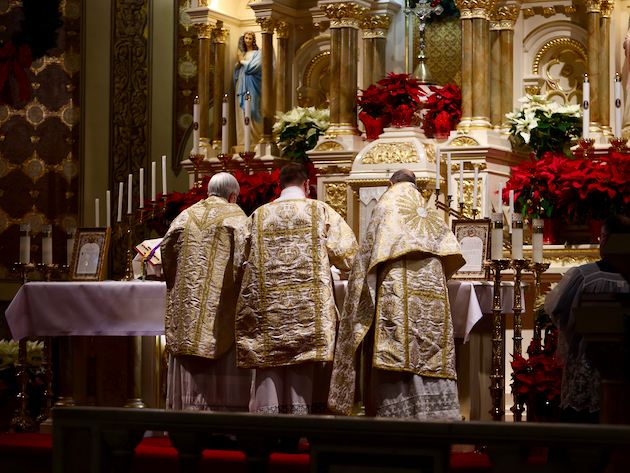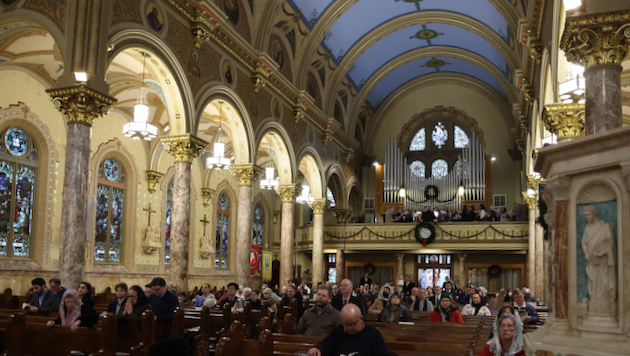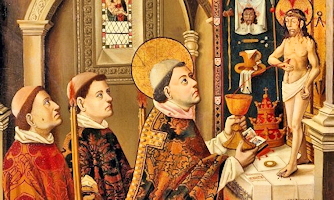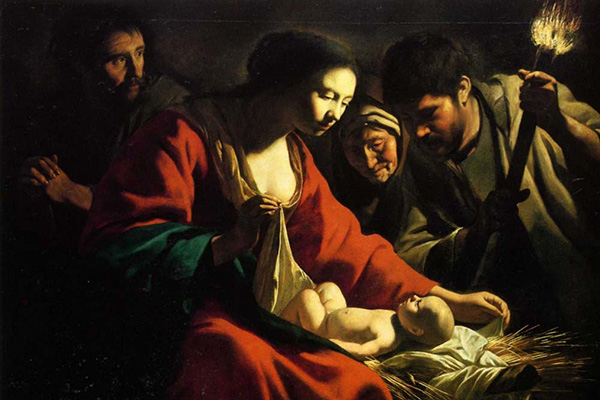
(photos courtesy of Stuart Chessman)
On Sunday afternoon of January 14, 2024, the final traditional Latin Mass offered in New Haven with the permission of the Archdiocese of Hartford for 38 years was celebrated at St. Stanislaus Church. The suppression of this regular celebration of the traditional Latin Mass in New Haven is a sad event in the history of our Society and a cruel deprivation to faithful Catholics in the New Haven community who are devoted to the age-old form of the liturgy of the Western Church.
Attended by a congregation of nearly 250 souls, the celebration of a Solemn Votive Mass in honor of our Patron, St. Gregory the Great, was a deeply devotional offering of the Holy Sacrifice. The Priestly Ministers–Celebrant, Deacon, and Subdeacon–were assisted by a full complement of Servers at the Altar. The Schola Cantorum of the Society aided by guest singers from other choirs, performed the Gregorian chants of the feast and William Byrd’s Mass for Three Voices. The Reverend Richard G. Cipolla’s remarkable sermon (posted below) served as a most apposite reflective meditation on the liturgy as it was experienced. All in all, it was a grand observance of a grim occasion.
Sermon preached at Final Mass by The Rev’d. Richard G. Cipolla (text courtesy of Stuart Chessman)
“At a certain point the wine ran out, and Jesus’ mother told him, ‘They have no more wine.’ Jesus replied, ‘Woman, how does this concern of yours involve me? My hour has not yet come’. His mother instructed those waiting on table, ‘Do whatever he tells you.’” (John 2: 3-5)
The changing of water into wine, always the gospel for this Sunday, the third sign of the Epiphany: the adoration of Christ by the Wise Men, the Baptism of Christ, and the changing of water into wine. This is the first miracle of Jesus and the first of the seven signs in the gospel of John, the signs that point to who Jesus is, the signs that show forth his glory, in a hidden way, for his glory is only shown forth finally on the cross. This is a most homely miracle: no healing here, no miraculous feeding, no casting out of demons. It surely pales before the raising of Lazarus, the final sign before the glorification of the Passion and Resurrection. But it is such a wonderful miracle. It is purely gratuitous; it is overflowing with extra. The water changed into wine gives pleasure to the wedding guests; the choice wine was saved for last. And so much of it! Six jars of twenty-five gallons apiece.
But that is not the heart of this gospel. The heart of this gospel is the manifestation of Christ to his disciples. But close to this heart, beating simultaneously with it, is the meaning of Mary’s role in our redemption. The heart of this gospel is Jesus Christ; but the wedding feast at Cana is where the biblical foundations of devotion to Mary are found, those foundations that end as they must, as all devotions must, at the foot of the Cross. One of the fundamental differences between Catholicism and Protestantism is the role of Mary in faith and piety. Devotion to Mary is one of the constants of the Catholic faith, and it is this devotion that is the evidence of a living faith in Christ. The rejection in Protestantism of Mary’s role in Christian faith has had the result of a widespread loss of understanding of who Jesus is. For without Mary, the reality of Jesus Christ is compromised.
They have no more wine. Woman, how does this concern of yours involve me? My hour has not yet come. Does not this exchange between Jesus and his mother give us pause? His address to her: Woman. Not Mother: Woman. We can rush to point out that this was a polite form of address in Semitic culture. The problem here is the translation. There is no way to say this in English as it would have been said in Aramaic. But the meaning of the gospel does not ultimately depend on language and culture. The conversation between Jesus and his mother—and please note that John the Evangelist never calls Mary by her name: he always refers to her as the mother of Jesus—this conversation is important to Christian faith because of what it says about Mary and the therefore about Jesus, for Mary always points to Jesus.
Where do we begin in understanding this conversation? We begin with the Revelation of St. John, where the Woman—that is the term used—is that mysterious, symbolic figure who is a key figure in the drama of salvation. She is the Woman who gives birth to the male child and enters into conflict with the dragon serpent. The imagery here forces us back to the third chapter of Genesis, to the Fall, where enmity is place between the serpent and the woman, between the serpent’s seed and her seed. In Revelation the Woman in birth pangs brings forth a male child who is the Messiah and is taken up into heaven. The great dragon, identified as the ancient serpent of Genesis by Revelation, frustrated by the child’s ascension, turn against the Woman and her offspring. Tradition understands this Woman as the people of God, the new Israel. Tradition understands this Woman as the Church who continues on earth after the Ascension, persecuted but protecting her children. But the Tradition of the Church identifies this woman, the Woman, also as Mary, the mother of Jesus, the mother of the Messiah. For it is Mary who is the symbol of the Church in the deepest sense, Mary who is the mother of the Church, but above all, Mary who is the new Eve, who by her Yes overturns the bondage and death of Eve’s No.
This is the context is which we must understand the conversation between Mary and Jesus at the wedding feast at Cana. It is Mary, the mother of the Messiah, the new Eve, who utters the words: they have no wine. This is not only a fact; it is a request to perform a sign that will show the glory of God in the Savior of the world. But before Jesus performs this sign, he must make clear his refusal of Mary’s intervention—how does this concern of yours involve me? She cannot have any role in his ministry. His signs must reflect the absolute sovereignty of his Father, not any human or family agency. What he must do, he must do alone, he who was born not by blood, not be carnal desire, nor by man’s willing it, but by God. But it is the new Eve who makes this request. It is the handmaid of the Lord who makes this request. And so just as Eve’s request of Adam brought sin into the world, so Mary’s request is the occasion of Jesus’ epiphany to his disciples, the first manifestation of his glory. And this request is granted: the water is changed into wine. But Mary’s ministry, her role in the redemption, must wait, must wait until the glorification of her Son, the final manifestation, the final epiphany. It is only at the final battle between the Son and the serpent that is waged on the Cross: it is only the hour of passion, death, and resurrection and ascension. Here is Mary’s fundamental role, her ministry. It is as the Woman: Woman, behold your Son! Here is the final struggle of the Woman with the serpent. It is here that she is entrusted with offspring whom she must protect in the continuing struggle between Satan and the followers of the Messiah. Here at the foot of the cross is Mary, mother of the Church. Here Mary is our mother, our protector, we who are the offspring of the Church, we who have been born again at the font by water and the Holy Spirit. Here is our Lady of Perpetual Help, here is our succour, our light, our sweetness and our hope, here is the Mother of all Christians, enveloping us in her mantle, the mantle that warmed the hillside of Tepeyac so that roses bloomed in the winter.
So many words, too many words, all of this, so much breathing out into the void! But how else to say this which must be said? Much better to go to Chartres to see who Mary is in the stone of the vaulting that soars to heaven and in the windows filled with the deep blue and blood red glass that speak so eloquently of beauty, of the Woman, and the glory of her Son. Much better to go to Torcello to see the Byzantine mosaic in the apse of the cathedral and see in that severe gold and blue the steely courage of the Theotokos, the bearer of God. Much better to go to my grandmother’s parish church in Campagna to see the heartbreaking statue of the Madonna Addolorata, our Lady of Sorrows, her heart pierced by swords, lovingly dressed in her liturgical outfits, her fragile porcelain face marked by tears, and here understand the deep suffering love that is Mary’s love for her Son and for the Church. Much better to join in singing the solemn tone of the Salve Regina, for it is the act of singing this hymn that the deepest understanding takes place, that water into wine makes sense, that my life in Christ makes sense—that Love makes sense.
And yet—and yet—we cannot pretend that this is just another Second Sunday after Epiphany and just look forward to the next year when this Gospel is sung, the singing itself an echo of the very molecules of water that were in those large vats at the wedding feast, those molecules that were surprised in their ordinariness of a v-shaped molecule with a `108° angle with the oxygen at the top of the molecule by the sudden presence of ethanol molecules with their little chains and the phenolic compounds that come from the grapes whose complexity lies at the heart of the mystery of wine. You cannot reduce wine to its chemical components. For wine is after all a mystery, which both Jesus and his mother understood, as work of human hands that can never be reduced to its components but rather can only be understood in terms of the happiness of the bride and groom and the wedding guests at that wedding. The Mass of Catholic Tradition, whose growth lies hidden in history, cannot be analyzed by listing its parts or by examining it as if it were an historical document. Like wine, this Mass is an experience, not a text.
How wonderful that the setting of the Ordinary of this Mass today is William Byrd’s Mass for Three Voices, written by the Catholic Byrd during the Elizabethan persecutions. The liturgy in the Book of Common Prayer is marked by wonderful English. Just the Advent Collects, translated by Thomas Cranmer, are masterpieces of English and masterpieces of the attempt to translate Latin into any language. But yet, yet, this is manufactured beauty. It is not organic. It did not come from the womb of Catholic Tradition that gave birth not merely to Councils with their edicts, but also, and just as importantly, to Collects and the Canon of the Mass and just as important to that Gregorian chant that makes words come alive in a way that points in a visceral way to the heaven that lies at the heart of the Mass.
If I were to be elected Pope, which is possible but highly unlikely, I would canonize William Byrd for his courage in a time of persecution. But even more for his understanding of the intrinsic relation between music and the Mass, a relation that has had a rocky road for centuries after Byrd and Tallis and Palestrina and Victoria and yes, even the great Bach, culminating in the tragedy of the 1960’s and 70’s.
I cannot help but feel sorrow on this day. I feel sorrow for this church, this building itself, a place built by immigrants to this country who because they understood the role of beauty, not only in the building itselft, but also in what the building is built for, the Holy Sacrifice of the Mass. The Mass for which this church was built will no longer be celebrated here, and if walls could weep, they would be weeping at this very moment. This is an age in which the Church has forgotten the three names of God: Truth, Goodness, and Beauty. Lip service is given to Truth and to Goodness. But the denial of the beauty that lies at the very heart of the Mass, that is ever ancient, ever new, all for which St. Gregory worked so brilliantly is a sign of blindness to the fact that beauty has saved the world, beauty is saving the world, beauty will save the world.
But there will come a time when the beauty of our Catholic Tradition will be rediscovered. And that time has already begun. Those young people, those Yale students, who come to this Mass more and more frequently, have discovered the relationship between the Mass and the Beauty of God–something that they had never thought of before or experienced. And there are others who are experiencing this relationship elsewhere, and they are the future of the Church. All the young people here, you are the future of the Church, not those mired in the 1960s and 1970s. When I am tempted to get mad or sad about the state of the world and the state of the Church, I remember Jesus’ words: “Fear not, little flock, for I have overcome the world”.
So now after this barrage of words that always fade into nothing, we proceed to the heart of the matter, where words do not merely change water into wine, but words effect an infinitely greater miracle, but not merely words or mere words or random words but the words of Him through whom the universe was created: Hoc est corpus meum. And there is nothing else to say. But much more to sing. And we will sing again.



